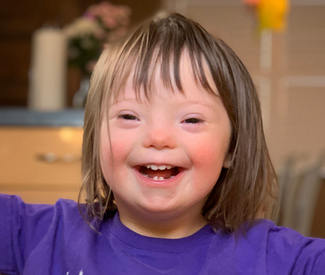The US Centers for Disease Control (CDC) estimates that 6,000 babies born in America each year have Down syndrome. It affects around 1 out of 7,000 babies, making it one of the more common and debilitating genetically inherited conditions.
Let’s explore what Down syndrome is, its signs and symptoms, different types of Down syndrome, and current treatment strategies.
What is Down syndrome?
Down syndrome is a genetic syndrome caused by having an extra copy of Chromosome 21. At conception, a fertilized egg usually has 23 pairs of chromosomes. In Down syndrome, there are 3 copies of genetic material on Chromosome 21. This changes the normal development of the brain and body.
Down syndrome is the most common chromosomal defect in humans.
What are the signs and symptoms of Down syndrome?
Typical signs and symptoms of Down syndrome include:
- Mild to moderate decrease in IQ
- Low muscle tone
- Developmental delays
Typical physical signs of Down syndrome are:
- Flat face with an upward slant to the eyes, short neck, and abnormally shaped ears
- A single deep crease in the palm of the hand
- White spots on the iris of the eye
- Small hands and feet

Associated health conditions can include:
- Heart defects
- Hearing problems
- Intestinal problems such as blocked small intestine or esophagus
- Celiac disease (sensitivity to gluten)
- Eye problems, such as cataracts
- Thyroid dysfunctions
- Skeletal problems
- Dementia-similar to Alzheimer’s
The three types of Down syndrome
There are three main types of Down syndrome. They vary by the presence and distribution of chromosome 21 in cells:
- Trisomy 21. This is by far the most common type of Down syndrome, accounting for 19 out of 20 patients with the condition. The defining feature of Trisomy 21 is that each cell in the body contains 3 distinct chromosome 21 copies as opposed to the usual 2.
- Translocation Down syndrome. About 3% of Down syndrome patients have Translocation Down syndrome, characterized by all or part of the extra third chromosome 21 being attached (“translocated”) to another chromosome.
- Mosaic Down syndrome. The third and rarest type (affecting 2% of patients) of Down syndrome is called Mosaic Down syndrome. Meaning “mixture,” Mosaic Down syndrome indicates that the patient has some cells with three sets of chromosomes and some cells with the healthy number of two sets of chromosomes. Patients with Mosaic Down syndrome might exhibit fewer or less severe symptoms as Down syndrome patients with the previous two types due to the presence of cells with the normal quantity of chromosome 21.
How is Down syndrome diagnosed?
The first step in the Down syndrome diagnostic process is an ultrasound and/or blood test in utero as the baby develops. During the ultrasound, the lab tech will look for a telltale sign of Down syndrome – the buildup of fluid around the baby’s neck, which is often indicative of a genetic issue.
If Down syndrome is suspected based on these initial screening measures, doctors will move on to more definitive diagnostic procedures to detect abnormal chromosomal makeup such as:
- Percutaneous umbilical blood sampling (PUBS)
- Amniocentesis
- Chorionic villus sampling (CVS)
How is Down syndrome treated?
Down syndrome cannot be cured. However, there are interventions that can allow the child to function at their optimal level.

These include:
- Speech, Occupational, and Physical therapies
- Special education classes
There’s no one-size-fits-all approach when it comes to treating Down syndrome. Optimal therapeutic protocols will vary from patient to patient depending on their individual needs and the type and severity of their condition.
Ideally, a Down syndrome patient will have an entire team of professionals helping him or her reach his or her full potential. This professional support network includes a roster of:
- social workers
- speech therapists
- physicians
- special educators
- occupational therapists
- physical therapists
The research indicates that early intervention in children with Down syndrome can make a significant positive impact on their quality of life and health across the lifespan, which is why seeking professional care early on is so important.
Neurologists and geneticists are hard at work coming up with both improved therapies as well as, down the road, potentially prevention through genetic engineering:
“DS was once thought to be an intractable condition because of the genetic complexity underlying it. Here, we have described recently reported breakthroughs in the understanding of Hsa21 trisomy, illustrating that research efforts in this field are making significant strides to understand and to develop treatments for the debilitating aspects of the syndrome.”

What are the risk factors for Down syndrome?
Risk factors for Down syndrome include:
- Advancing age of the mother, especially after 35
- Already having had a child with Down Syndrome
- Parents who themselves have an abnormality with Chromosome 21
Contact Child Neurology Center of Northwest Florida to learn more about Down syndrome
If you’re a concerned parent with further questions about Down syndrome and how modern neurology can help patients live their best lives possible, please contact us. We’re happy to share our extensive clinical knowledge with our Northwest Florida neighbors.
For further information, you can also contact the National Down Syndrome Society, recognized as the leading national authority on Down syndrome and its treatment.




